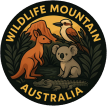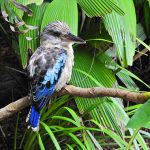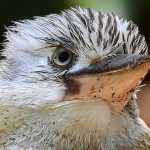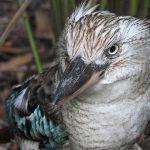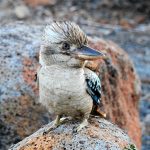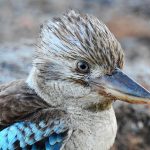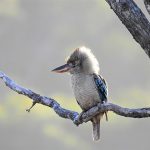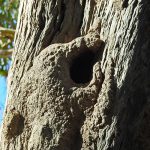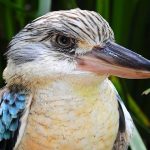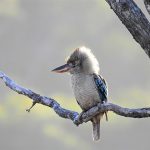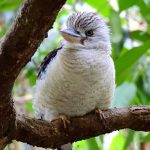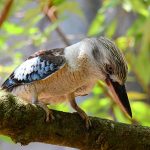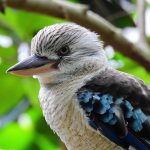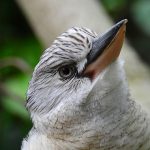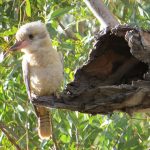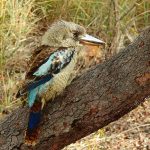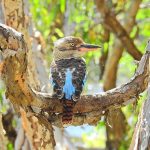BLUE-WINGED KOOKABURRA
Nature’s Lively Storyteller
Few birds capture the attention of both locals and visitors in northern Australia quite like the Blue-winged Kookaburra. With its distinctive cackle and vibrant plumage, this remarkable bird plays a unique role in the rhythm of Australia’s wild spaces.
Scientific Snapshot
- Common Name: Blue-winged Kookaburra
- Scientific Name: Dacelo leachii
- Family: Kingfisher family (Alcedinidae)
Vivid Description
Picture yourself in a sunlit Eucalypt woodland, the air hazy with early morning mist. From a nearby branch, you hear a chorus reminiscent of wild laughter. Peering closer, you spot the Blue-winged Kookaburra—its feathers a patchwork of earthy browns, crisp whites, and, most strikingly, electric blue along its wings and tail.
- Size: About 38–42 cm long, larger than many kingfishers
- Plumage:
- Dappled brown and white across the body
- Intense, cobalt-blue patches on the wings and tail
- Call: Unlike the well-known “kookaburra laugh” of its cousin, the Laughing Kookaburra, the Blue-winged Kookaburra’s call is a raucous, metallic cackling often described as maniacal and far-reaching—echoing through forests and watercourses.
Natural Habitat
| Region | Description |
|---|---|
| Northern Australia | Wet forests, mangroves, open woods, river edges |
| Southern New Guinea | Similar habitats |
Winding rivers, coastal mangroves, and tropical savanna are typical haunts. The air here is humid, scented with blooming native plants and damp earth, providing a rich tapestry of sounds, colours, and scents that frame the kookaburra’s daily life.
Daily Life and Diet
Blue-winged Kookaburras are accomplished hunters. Watch as one perches, motionless, eyes sharp and scanning the ground below.
- Diet:
- Large insects
- Small reptiles (such as skinks and geckos)
- Frogs and the occasional small mammal
- Behaviour:
- Hunts from a low perch
- Launches swiftly for prey, held fast in its strong beak
Touch: You would notice their powerful, stocky build if ever gently handling a rescued individual—these birds are made for seizing and subduing wriggling prey.
Family and Social Bonds
Blue-winged Kookaburras live in close family groups. They nest in tree hollows or termite mounds, working together to care for the young. There’s a strong sense of community—juveniles often stay and help raise their younger siblings, a touching reminder of the interconnectedness of wild lives.
Conservation and Coexistence
- Status: Not currently threatened, but sensitive to:
- Loss of nesting trees
- Habitat alteration
Every encounter with a Blue-winged Kookaburra is a gentle invitation to appreciate Australia’s unique birdlife and the complex web of life it inhabits. By conserving native forests and riverbanks, we secure not just the future for this charismatic bird, but for countless other species sharing its home.
Quick Facts Table
| Feature | Detail |
|---|---|
| Wingspan | Up to 63 cm |
| Call | Harsh, cackling, far-carrying |
| Range | Northern Australia, southern New Guinea |
| Lifespan | Up to 20 years in the wild |
Why They Matter
The Blue-winged Kookaburra is more than just a bird—it’s a voice in Australia’s wild chorus, a visual marvel, and a key predator in its ecosystem. Each time you hear its call, remember the intricate harmony of wild places and the shared responsibility to keep them vibrant for generations to come.
Photo Gallery
Sharon: Had a great ‘Close Encounter’ with the stunning Blue-winged Kookaburra when we were travelling through Cape York in Northern Australia. This well-known ‘Bird of the Bush’ landed on rock nearby to were i was sitting, giving me the perfect opportunity to take my ‘Aussie Critters’ video. I watched on as he hunted for bugs and Lizards.
